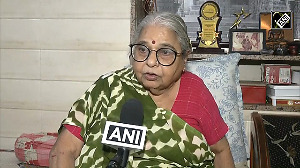Modern format retail is witnessing phenomenal growth, driven by the impact of increasing urbanisation, the new well-travelled, knowledgeable Indian consumer and a youth-driven culture. In its official estimate for the current fiscal ending in March, the government said that the economy, Asia's fourth-largest, was expected to grow at 9.2 per cent.
India once again topped the world in the ACNielsen Consumer Confidence Index for the third time in a row since the index was established in early 2005, with the highest score of 131 in the last leg of the survey, conducted in November 2006.
Strong economic growth has brought with it new sets of Indian consumers. The booming young adult population with unprecedented levels of disposable income is more conscious of the latest trends and fashion. Enhanced media penetration and greater connectivity also are making consumers more knowledgeable and discerning.
All these factors are rapidly changing the needs and aspirations of consumers. Schedules are also getting tighter, with the time for professional commitments and regular chores getting limited. Hence, the "convenience" factor has a major influence on purchase decisions.
Modern trade, the characteristic of which is having everything under one roof and with a great array of products displayed in an uncluttered fashion where the touch and feel factor prevails, is providing an environment to access products driven by convenience and fashion.
Modern trade in India
is an old saga in India with about 7.8 million retail stores, but most of those are traditional ones, which only recently started making way for hypermarkets, supermarkets and specialty stores. Modern trade in India is witnessing tremendous growth, especially in Tier I cities.
It accounts for 4 per cent of urban FMCG sales but for the top 15 metros it is about 9.7 per cent of the total FMCG sales. For South Indian metros it touches about 16 per cent, because modern trade started there a little earlier. There are more than 3,430 modern trade stores in India now.
Impact on FMCG
Looking at the kind of consumer patronage a modern trade format store has in terms of an urban population growing rich, there are a few segments in the FMCG range of products that have experienced good growth from the modern trade format. In the food segment, processed food products (23 per cent), impulse food products (32 per cent) and packaged grocery (38 per cent) are the segments that have witnessed immense growth from urban Indian modern stores.
Similarly, in the home and personal care segments it is household cleaning products (38.1 per cent), fabric care (23 per cent) and categories related to grooming, viz. hair care (28.3 per cent), fragrances (26 per cent) and skin/body care (23 per cent) that have recorded considerable growth from urban modern format stores.
An increasing number of working women and nuclear families are some reasons behind the growth in the food categories. Packaged grocery is a very convenient product for people who are busy and hence we see it doing so well. Again the young adult population of India is ambitious and hard-working, and has the money to spend on lifestyle. They are brand-conscious and aware of what their counterparts in the West are wearing and buying.
No wonder products related to grooming like like skin care, hair care, and fragrances, or, for that matter, products like household cleaners are witnessing growth. These consumers represent the target for manufacturers and retailers, who want to capture a share of the booming consumer markets in India. Manufacturers, on their part, are investing aggressively to capture the minds of today's and tomorrow's generations.
With more modern format stores setting up shop in the country we are also witnessing an expansion in these segments in terms of availability of innovative packaging sizes, product innovation and overall ranges.
Modern trade and food as a category: Food accounts for about 48 per cent of FMCG sales in the country and for modern trade the number is even higher, at 51.3 per cent. Like other Asia-Pacific markets, in India too, among the processed food segments, the breakfast cereals category is exhibiting a stupendous 40 per cent growth rate. Other growing categories are biscuits (26 per cent), vermicelli & noodles (28 per cent), beverages (24 per cent) and ketchup and sauce (29 per cent).
Indians have an old fascination for home-cooked food, especially when it comes to lunch and dinner. With the changed lifestyle, the trend is changing and people have started showing interest in ready-to-cook foods. However, even today a majority of these consumers are willing to restrict the experiment to packaged foods and accompaniments meant for breakfast and snack time.
Chocolates (28 per cent) and namkeens (37 per cent) are two major categories of impulse food products showing good growth, along with packaged rice (92 per cent) in the packaged grocery segment.
Modern trade and home and personal care products (H&PC): As far as H&PC is concerned, from modern trade it has witnessed a growth rate of about 23 per cent, which is at par with the overall growth. Modern trade brings with it a great shopping experience, with good product displays, making selection far easier.
Under household cleaners it is floor cleaners (88 per cent) and toilet cleaners (37 per cent) that are growing well; in hair care, it is hair conditioners (43 per cent) and hair oil (35 per cent), and for the skin care segment, it is skin creams (35 per cent) that are driving the H&PC sales in modern stores.
With the overall economy doing well and basic necessities mostly taken care of, people are now more keen to look and feel good and are ready to devote time and money on that. Unlike in the past, when there was one product used for all household cleaning, people now are willing to experiment with specific products meant for cleaning glasses, utensils, floors, etc.
Modern stores and their challenges
It's a very competitive situation with more and more new players entering the market. There are Reliance, the Tatas, the Birlas, ITC, and foreign players like Wal-Mart now. India is a market where from time immemorial existed the mom and pop grocery stores and I don't see them going away so soon.
Looking at our vast consumer profiles, both traditional grocery stores and modern format retail stores will exist side by side. People with low incomes will keep visiting local grocery stores for the credit facilities they get and the frequent top-up shopping they do whereas the middle and upper income households would love to do their monthly shopping from the modern format retail stores with occasional top-up shopping from the local grocer.
The other end of the spectrum would be rural India, where again a lot is happening but it will take time for its effect to be felt.
The author is Associate Director, Client Services, The Nielsen Company, India.






